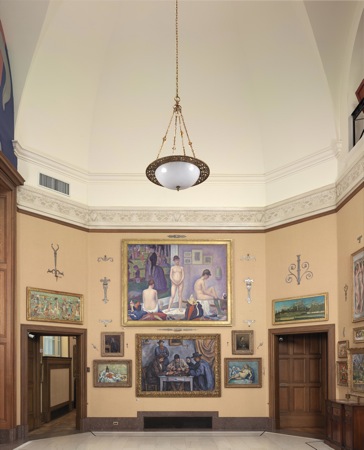
Courtesy Barnes Foundation
The large concentration of world-class cultural museums along Philadelphia’s Franklin Parkway is about to get its first new neighbor in 60 years, and it will be an impressive addition to the area.
The Barnes Foundation is moving its world-renowned collection of French impressionist, post-impressionist and early modern paintings from its longtime home in nearby Merion, Pa., to a large new building on the parkway.
Ribbon cutting on the 93,000-square-foot building with its textured limestone exterior overlaid on strips of recessed steel is scheduled for May 19.
“It is next door to the Rodin Museum, less than a half-mile from the Philadelphia Museum of Art and across the street from the Franklin Institute,” said Andrew Stewart, public relations director for the foundation.
“The main thing is the permanent collection, the fabulous collection of art that Dr. [Albert] Barnes amassed during his lifetime.”
The collection includes 181 works by Pierre-Auguste Renoir and 69 by Paul Cézanne, considered the largest collection of the two artists in the world. “From there it goes on and on,” said Stewart.
Barnes, a chemist and avid art collector, created the Barnes Foundation in 1922 to display his collection and to foster art education and appreciation. Barnes hung the artworks in unconventional, eclectic ways in relatively small rooms in his specially designed house on a 12-acre arboretum in Merion to enhance their educational impact.
The walls have remained the same since he died in 1951.
“The gallery will be displayed in exactly the same configuration as in Merion,” said Stewart. “People will still have the same experience.”
The Barnes collection also includes African sculpture and Pennsylvania Dutch decorative arts.
Although the gallery space is relatively the same size as that in Merion, the new building will have much larger spaces for classrooms, administrative offices and conservation work. It will also have an interior garden.
Another new addition to the comprehensive Philadelphia art scene is the latest Claes Oldenburg public sculpture, a 51-foot-tall, overturned paintbrush with red bristles that are illuminated; the exhibit opened Oct. 1 on the Philadelphia Academy of Fine Arts’ new $7.5 million Lenfest Plaza.
Philadelphia has an aggressive public art program; more than 50 years ago, it became the first city in the country to require that a percentage of construction costs for city projects and redevelopments be set aside for fine arts.
There are nearly 300 pieces around town, including three others by Oldenburg and the famous “Love” sculpture by Robert Indiana that has become a city icon.
The city has also become known as the City of Murals because of its innovative murals program that began more than 25 years ago as an effort to combat graffiti.
Today, there are more than 3,000 murals on the sides of buildings throughout the city, with more being added each year. The subjects often deal with the cultures of local neighborhoods, and the mural arts program operates a variety of tours.










